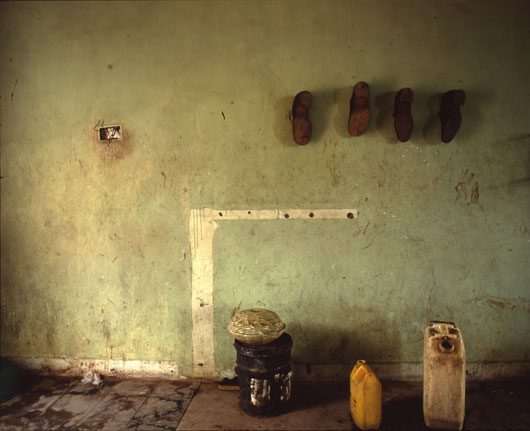Since 1990, the Venice Biennale has devoted increasing attention to presenting artistic productions by artists from Africa and the diaspora. In 2003, the founding director of Iniva (Institute for International Visual Arts), Gilane Tawadros, curated the exhibition entitled ‘Fault Lines: Contemporary African Art and Shifting Landscapes’. Yvette Mutumba looks back and offers a summary commentary on the exhibition.

Zarina Bhimji, 'Memories Were Trapped Inside the Asphalt', 1998-2003, Transparency in light box 130 x 170 x 12.5 cm. © Zarina Bhimji.
‘Dreams & Conflicts: The Dictatorship of the Viewer’ was the theme of the Venice Biennale in 2003. According to Francesco Bonami, the themes to which that year’s Biennale was to address itself were the themes of the dream and the conflict, the entire world in contrast with its political and geographical fragmentation, and national efforts versus international accomplishments. In the exhibition entitled ‘Fault Lines: Contemporary African Art and Shifting Landscapes’, curator Gilane Tawadros seized upon the aspect of political and geographical fragmentation in regard to perspectives in African art.
In geology, ‘fault Lines’ are gaps in the earth’s crust or the edges of continental tectonic plates. ‘Fault lines may,’ Tawadros points out, ‘be a sign of significant shifts, or even of impending disaster, but they also create new landscapes.’ The situations of artists in Africa and the diaspora are marked by faults and shifts, but also by the creativity in which these gaps and movements result. It is the results of colonialism and postcolonialism, of globalisation and migration that, according to Tawadros generate faults in our world. The curator selected positions that were ‘shaping contemporary existence locally and globally.’ The fourteen invited artists broached this topic with works in a variety of media – photography, painting, architecture and installation.
.
With her camera, Zarina Bhimji traced the legacy – the scars and traces – of colonialism, in objects, architecture and landscapes. In the ‘Fault Lines’ exhibition she exhibited her work entitled Memories Were Trapped Inside (1998 – 2003). A room, apparently long-abandoned, silently testifies to a life gone by, to a story of utilisation and exploitation. There are four shoes hanging up against a dirty wall. An electrical outlet has been removed, exposing now-superfluous wiring.
Kader Attia transformed a snack vending machine into a Machine à Rêves (Dream Machine) (2002-3). In place of sweets, the vending machine offered objects representative of the dreams of youths from the Maghreb living in the urban outskirts of France and hoping for status and wealth. While Attia focused in his work on the longings and needs within an urban microcosm, with the installation entitled Temporal Distance (with a Criminal Intent). You will find us in the best places… (1997), Moshekwa Langa took a bird’s-eye view of the complicated mesh of social relationships within urban structures. Rolls of yarn, woollen thread, bottles and toy cars were stand-ins for the complicated and not infrequently bewildering connections among work, consumption, exploitation and dependency.
These are just three examples of complex positions that encompassed five decades and three generations. ‘Fault Lines’ presented a many-faceted picture of artistic production on the African continent and in the diaspora. The show stood in opposition to any and all notions of one-dimensional, ‘authentic’, ‘African’ contemporary art. It was the appropriate sequel to the preceding presentation in Venice of contemporary art from Africa and the diaspora: the 2001 exhibition curated by Salah Hassan and Olu Oguibe and entitled ‚Authentic/Ex-centric: Conceptualism in Contemporary African Art’. This exhibition offered an attempt to come to terms with the debate on the demand for authenticity and the exotic that, outside of the continent, represents the criteria for recognition and validation of contemporary art from Africa.
.
With ‘Fault Lines’, Gilane Tawadros presented aspects of multiple iterations of modern African art. This made the exhibition an important consolidation of the idea of laying out the multi-layered and differentiated developments of these modern arts, an idea first compiled and analysed in an exhibition entitled ‘The Short Century – Independence and Liberation Movements in Africa 1945-1994’ (2001), by Okwui Enwezor. ‘Fault Lines’ also contributed to the debate on globalisation and the transnational intermingling of aesthetic and artistic concepts. At a time in which contemporary art by artists in Africa and the diaspora was even more marginalised than it is today, this exhibition constituted an important intervention within the context of the Western art scene. It offered African perspectives on the effort to come to grips with (post)colonialism, home and the foreign and themes of belonging, while at the same time underscoring the act of laying claim to cultural space. From this point of view, ‘Fault Lines’ was a pioneering project, one that made a decisive contribution to all-too-often homogeneous perceptions of art production on the African continent and in the diaspora.
Dr. Yvette Mutumba is Research Curator for Africa at the Weltkulturen Museum in Frankfurt am Main and co-initiator of C&.
The exhibiton’s catalogue was edited by Gilane Tawadros and Sarah Campbell.
Translated from German by Steve Britt.
More Editorial